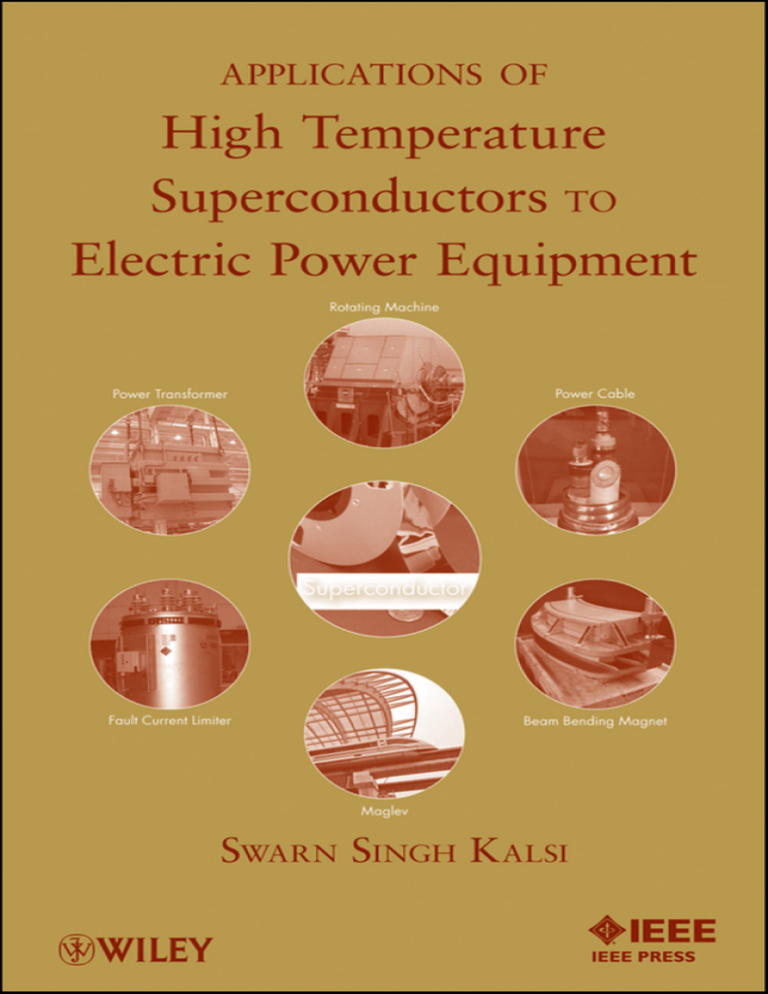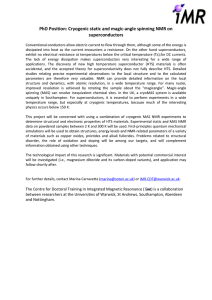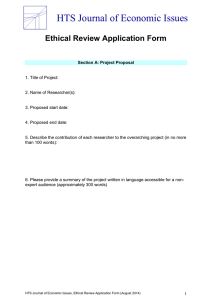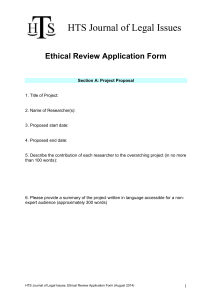
APPLICATIONS OF
HIGH TEMPERATURE
SUPERCONDUCTORS
TO ELECTRIC POWER
EQUIPMENT
IEEE Press
445 Hoes Lane
Piscataway, NJ 08854
IEEE Press Editorial Board
Lajos Hanzo, Editor in Chief
R. Abari
J. Anderson
F. Canavero
T. G. Croda
M. El-Hawary
B. M. Hammerli
M. Lanzerotti
O. Malik
S. Nahavandi
W. Reeve
T. Samad
G. Zobrist
Kenneth Moore, Director of IEEE Book and Information Services (BIS)
Technical Reviewers
Richard J. Gran
Mathematical Analysis Company
Heinz-Werner Neumüller
Siemens AG
APPLICATIONS OF
HIGH TEMPERATURE
SUPERCONDUCTORS
TO ELECTRIC POWER
EQUIPMENT
Swarn Singh Kalsi
IEEE PRESS
A JOHN WILEY & SONS, INC., PUBLICATION
Copyright © 2011 by Institute of Electrical and Electronics Engineers. All rights reserved.
Published by John Wiley & Sons, Inc., Hoboken, New Jersey.
Published simultaneously in Canada.
No part of this publication may be reproduced, stored in a retrieval system, or transmitted in
any form or by any means, electronic, mechanical, photocopying, recording, scanning, or
otherwise, except as permitted under Section 107 or 108 of the 1976 United States Copyright
Act, without either the prior written permission of the Publisher, or authorization through
payment of the appropriate per-copy fee to the Copyright Clearance Center, Inc., 222
Rosewood Drive, Danvers, MA 01923, (978) 750-8400, fax (978) 750-4470, or on the web at
www.copyright.com. Requests to the Publisher for permission should be addressed to the
Permissions Department, John Wiley & Sons, Inc., 111 River Street, Hoboken, NJ 07030,
(201) 748-6011, fax (201) 748-6008, or online at http://www.wiley.com/go/permission.
Limit of Liability/Disclaimer of Warranty: While the publisher and author have used their best
efforts in preparing this book, they make no representations or warranties with respect to the
accuracy or completeness of the contents of this book and specifically disclaim any implied
warranties of merchantability or fitness for a particular purpose. No warranty may be created
or extended by sales representatives or written sales materials. The advice and strategies
contained herein may not be suitable for your situation. You should consult with a professional
where appropriate. Neither the publisher nor author shall be liable for any loss of profit or any
other commercial damages, including but not limited to special, incidental, consequential, or
other damages.
For general information on our other products and services or for technical support, please
contact our Customer Care Department within the United States at (800) 762-2974, outside the
United States at (317) 572-3993 or fax (317) 572-4002.
Wiley also publishes its books in a variety of electronic formats. Some content that appears in
print may not be available in electronic formats. For more information about Wiley products,
visit our web site at www.wiley.com.
Library of Congress Cataloging-in-Publication Data:
Kalsi, Swarn.
Applications of high temperature superconductors to electric power equipment / Swarn S. Kalsi.
p. cm.
Includes bibliographical references and index.
ISBN 978-0-470-16768-7 (cloth : alk. paper)
1. Electric machinery–Materials. 2. Electric power systems–Equipment and supplies.
3. High temperature superconductors–Industrial applications. I. Title.
TK2391.K185 2010
621.31′042–dc22
2010010789
Printed in Singapore.
10
9
8
7
6
5
4
3
2
1
To my wife
Kuldeep
My lifelong companion and aspirant
CONTENTS
Preface
xiii
Acknowledgments
xvii
Abbreviations
xix
1
Introduction
1
2
HTS Superconductors
7
2.1
2.2
2.3
2.4
2.5
2.6
2.7
2.8
2.9
3
Introduction / 7
HTS Background and Nomenclature / 8
2.2.1
Background / 8
2.2.2
Nomenclature / 10
BSCCO-2212 Conductors / 11
BSCCO-2223 OPIT Wires / 13
2.4.1
Manufacturing Process / 13
2.4.2
Characteristics—Electrical and Mechanical / 14
YBCO-123 Coated Conductors / 17
Magnesium Diboride (MgB2) / 23
State-of-the-Art of Various HTS Conductors / 26
Superconducting Magnet Design / 27
Summary / 32
References / 33
Cooling and Thermal Insulation Systems
3.1
3.2
3.3
3.4
35
Introduction / 35
Anatomy of a Cryostat / 36
Cryogenic Fluids for Cooling HTS Magnets / 37
Direct Cooling with Cryogens / 39
vii
viii
CONTENTS
3.5
3.6
3.7
3.8
3.9
3.10
3.11
4
Indirect or Conduction Cooling / 40
Refrigeration Systems / 41
3.6.1 Gifford–McMahon (G-M) Cryocoolers / 42
3.6.2 Stirling Coolers / 45
3.6.3 Pulse-Tube Coolers / 47
Open Loop Cooling with Liquid Nitrogen / 48
Magnet Materials / 48
Current Leads / 49
3.9.1 Current Leads for Low Temperature Magnets / 50
3.9.2 Design of Conduction Cooled Leads / 52
Example Cryostat Design / 53
3.10.1 Configuration / 53
3.10.2 Thermal Load Calculations / 54
3.10.3 Current Leads / 56
3.10.4 Conduction / 57
3.10.5 Selection of Refrigerator / 57
Summary / 58
References / 58
Rotating AC Machines
4.1
4.2
4.3
4.4
4.5
59
Introduction / 59
Topology / 60
Analysis and Parameter Calculations / 62
4.3.1 Magnetic Circuit and Harmonic
Components / 63
4.3.2 Parameter Calculations / 70
4.3.3 Machine Terminal Parameters / 79
Design / 89
4.4.1 Stator Winding Design Issues / 89
4.4.2 Field Winding Design Issues / 92
4.4.3 Electromagnetic (EM) Shield Design Issues / 96
4.4.4 Loss and Efficiency Calculations / 97
4.4.5 Example Design / 98
Manufacturing Issues / 108
4.5.1 Superconducting Field Winding and Its Cooling
Systems / 109
4.5.2 Torque Transfer from Cold Field Winding to
Warm Shaft / 112
4.5.3 Stator Winding / 112
CONTENTS
4.6
4.7
4.8
4.9
5
6
7.4
7.5
7.6
7.7
139
Introduction / 139
Principle / 140
Design Analysis / 142
Design Challenges / 142
Prototypes / 143
Summary / 144
References / 144
Transformers
7.1
7.2
7.3
129
Introduction / 129
Principle / 129
Configuration / 131
Design Challenges / 133
Prototypes / 136
Summary / 137
References / 137
Synchronous AC Homopolar Machines
6.1
6.2
6.3
6.4
6.5
6.6
7
Simulation / 113
Generators / 113
4.7.1
High-Speed Generators / 114
4.7.2
Medium-Speed Generators / 116
Motors / 121
4.8.1
High-Speed Motors / 121
4.8.2
Low-Speed Motors / 122
Summary / 126
References / 126
Rotating DC Homopolar Machines
5.1
5.2
5.3
5.4
5.5
5.6
ix
Introduction / 147
Configuration / 149
Design Analysis / 154
7.3.1
Core Sizing / 156
7.3.2
50-MVA Example Design / 157
Challenges / 167
Manufacturing Issues / 168
Prototypes / 169
Summary / 169
References / 169
147
x
CONTENTS
8
Fault Current Limiters
8.1
8.2
8.3
8.4
8.5
8.6
8.7
9
Introduction / 173
Principle and Configuration / 175
8.2.1 Resistive Fault Current Limiters (R-FCL) / 176
8.2.2 Inductive FCL with Shielded Iron Core / 180
8.2.3 Inductive FCL with Saturated Iron Core / 183
Design Analysis / 185
8.3.1
Example Design—Resistive FCL / 188
8.3.2 Example Design—Saturated Core FCL / 201
Challenges / 206
8.4.1 Challenges of Resistive FCL / 206
8.4.2 Challenges of Inductive FCL / 207
Manufacturing Issues / 208
Prototypes / 209
8.6.1 American Superconductor Corporation’s (AMSC)
Fault Current Limiter / 209
8.6.2 SuperPower’s Fault Current Limiter / 211
8.6.3 Zenergy Power’s Fault Current Limiter / 212
8.6.4 Nexans’s Fault Current Limiter / 213
Summary / 214
References / 215
Power Cables
9.1
9.2
9.3
9.4
9.5
9.6
173
Introduction / 219
Configurations / 222
9.2.1
Resistive Cryogenic Cable / 222
9.2.2
HTS Cable / 223
Design Analysis / 226
9.3.1
Cryogenic Cable Analysis / 226
9.3.2
HTS Cable Analysis / 231
Challenges / 243
9.4.1
Resistive Cryogenic Cable / 243
9.4.2
HTS Cable / 245
Manufacturing Issues / 249
9.5.1
Resistive Cryogenic Cable / 249
9.5.2
HTS Cable / 250
Prototypes / 252
9.6.1
Resistive Cryogenic Cable / 252
9.6.2
HTS Cable—High Voltage / 252
219
CONTENTS
9.7
9.6.3
HTS Cable—Medium Voltage / 254
9.6.4
TriaxTM HTS Cable—Medium Voltage / 256
Summary / 258
References / 258
10 Maglev Transport
10.1
10.2
10.3
10.4
10.5
10.6
10.7
11.3
11.4
261
Introduction / 261
Configurations / 262
10.2.1 Electrodynamic Suspension (EDS) / 262
10.2.2 Electromagnetic Suspension (EMS) / 265
Design Analysis / 269
10.3.1 Electrodynamic Suspension Maglev / 269
10.3.2 Electromagnetic Suspension Maglev / 272
Challenges (Technical/Economic) / 275
10.4.1 EDS System Challenges / 276
10.4.2 EMS System Challenges / 276
Manufacturing Issues / 277
Prototypes / 277
10.6.1 Northrop Grumman Concept / 278
Summary / 285
References / 286
11 Magnet Applications
11.1
11.2
xi
289
Introduction / 289
Air-Core Magnets / 291
11.2.1 High-Field Magnets / 291
11.2.2 Low-Field Magnets / 293
Iron-Core Magnets / 298
11.3.1 Beam Bending / 299
11.3.2 Induction Heating / 299
11.3.3 Synchrotron / 301
Summary / 302
References / 302
About the Author
305
Index
307
PREFACE
On the urging of many colleagues, I undertook this book project with
the objective of providing a reference source for designing power
equipment with the high temperature superconductor (HTS) developed in the late 1980s. The HTS technology is still in infancy, and both
the conductor and its applications are still evolving. The design and
analysis approaches discussed are based on experience gained and
lessons learned from many coworkers at General Electric Global
Research, Northrop Grumman, and American Superconductors over a
period of more than 35 years. My understanding of superconductor
applications was expanded tremendously during extended assignments
at the national laboratories (Oak Ridge National Laboratory and
Brookhaven National Laboratory) through association with fusion and
accelerator projects. In writing this book, I claim no credit for the original inventions or for anything more than a small part in their subsequent development. The book is merely an attempt to provide a
reasonably organized account of the fundamental principles of various
power equipment, the basics of the design methodology with example
designs, a description of prototypes constructed, and encouragement
for readers working to further the HTS technology.
The book presumes a familiarity with the fundamentals of design
and analysis of conventional power equipment like motors and generators, transformers, power cables, and electromagnets. The intended
audience for the book is electrical and mechanical engineers in the
power industry, government laboratories, and students at the senior/
graduate level in universities. Below is a description of topics covered
in each chapter.
Chapter 1 contains the introduction to HTS technology, HTS applications to power equipment, and the price goals necessary for the
success of this technology.
Chapter 2 provides information on the state of the art of
HTS technology. It covers the most popular HTS applications, the
xiii





